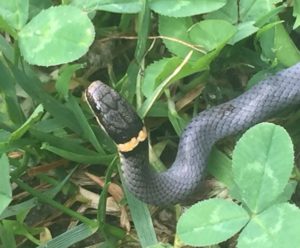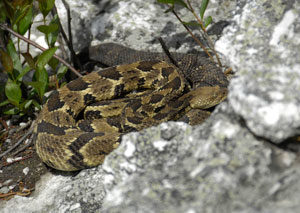Vol. 13 Issue 2, Summer 2008
By Bonnie Eaton
Most Snakes Are Harmless and Good for the Environment
“Why’d it have to be snakes?” This famous line from Indiana Jones says it all. People don’t like snakes. Even Indiana Jones, who can rescue a damsel in distress while leaping across a perilous ravine 300 feet deep, is terrified of snakes.

Copperhead snake
Photo by John White
According to a recent study by two researchers at the University of Virginia, our fear of snakes—one of the most common phobias in humans—is the result of evolution. They believe that early primates developed an acute awareness of snakes, and that this ability to detect their presence is now deeply encoded into our brains, including those of very young children. Apparently, surprising a puff adder or a black mamba in the wild was not a great idea, even then.
Add to this the biblical story of the serpent in the Garden of Eden and, well, you get the picture. We just don’t like snakes.
But the truth is snakes are not evil or sinister. Most are harmless and play a vital role in maintaining a healthy environment. They like their privacy. Even venomous snakes are not normally aggressive and would rather avoid humans altogether.
Although about 8,000 people are bitten every year by venomous snakes in the United States, only five to ten deaths occur each year. Loudoun County has only two species of venomous snakes to watch out for: the northern copperhead and the timber rattlesnake.
Here are a few basic facts about snakes:
- Just as humans must shed old skin to reveal new skin underneath, snakes periodically shed their skin. But instead of shedding their skin in tiny, undetectable bits—as we do—snakes shed their skin all at once.
- Snakes cannot generate their own body heat. This means they must avoid long periods exposed to the extremes of heat and cold. This is one of the reasons they seem to “hide.”
- Snakes have long slender bodies which allow them to swim, climb, and slip into tight places easily. Boasting anywhere from 200 to 400 vertebrae in their spines, snakes are extremely flexible.
- Snakes do not have ears, but rely on low-frequency vibrations from the air and ground to detect their prey.
- Snakes are carnivores. They eat insects, fish, amphibians, other reptiles, birds and their eggs, and rodents. They swallow prey whole thanks to lower jaws that are loosely attached to their skulls, and highly moveable upper jaws. Their forked tongues, which pick up odors, are completely harmless.
- Some snakes lay eggs, such as the ratsnake. Others give birth to live young, including garter snakes, brown snakes, copperheads, and rattlesnakes.
- Venomous snakes can be identified by their cat-like eyes, sensing pits (between each eye and nostril), wide heads (much wider than their necks), single anal plates, and single scales on the underside of their tails.
Snakes as Friends

Ringneck snake
Photo by Sharon Plummer
Virginia has 30 species of snakes. While your instinct may be to destroy every snake you see, don’t. Snakes are helpful to man and the environment. They eat many of the pests that destroy our agricultural crops. The ratsnake is the farmer’s friend and is always a welcome barn visitor. In the garden, snakes control annoying insects, slugs, and snails. Snakes are also food for other animals, such as hawks and great blue herons.
Medical science has seized upon the unique properties of snake venom, a complex mixture of proteins and enzymes. Researchers around the world are studying ways snake venom might be used to treat cancer, epilepsy, arthritis, and other human diseases.
Unfortunately, snakes are not as abundant as they once were. Their habitats are being destroyed to make room for suburban sprawl. They are evicted without warning. It’s important to remember this the next time you meet one on the road.
Snakes as Neighbors
Snakes are solitary creatures seldom seen by homeowners. The closer you live to their natural habitats—creeks, woods, and fields—the more likely you are to see them in your yard.
If you wish to discourage snakes from entering your yard, eliminate potential food sources and hiding places. Keep your lawn mowed and shrubbery trimmed. Clear away unwanted debris and wood piles. And don’t leave food outside where mice and rats will find it.
Stamp your feet or throw a stone to create vibrations to warn a snake of your approach. If you are accompanied by the family dog, it’s best to put man’s best friend inside until the snake has had the opportunity to find a hiding place.
To keep snakes outside where they belong, seal cracks and crevices in your home’s exterior, especially around the foundation. If you suspect a snake has entered an area, turn on the lights. Snakes are seeking dark hiding places. You can also use a broom to usher the invader outside. If you suspect a venomous snake, leave it undisturbed and seek professional help.
Educating yourself about snakes is the best way to coexist with these fascinating creatures. When it comes to snakes, we truly have nothing to fear but fear itself.
Here are photos of just a few of the species of snakes that we have here in Loudoun. Many thanks to John White of the Virginia Herpetological Society for use of the photos:
[ADD PHOTO OF EASTERN KINGSNAKE HERE]
Eastern Kingsnake (Lampropeltis getula getula). Shiny and black with a series of thin white to cream crossbars or spots on its back. Grows to a length of 36-48 inches.

Photo by John White
Northern Copperhead (Agkistrodon contortix mokasen). Venomous with a triangular head and cat-like eyes, coppery red hourglass pattern, growing to a length of 24–36 inches. Found throughout Virginia in a variety of habitats.
[ADD PHOTO OF EASTERN GARTER SNAKE HERE]
Eastern Garter Snake (Thamnophis sirtalis sirtalis). Anywhere from 5 to 48 inches long, with two to three lateral stripes. Stripes may be in shades of yellow, brown, blue, or green, usually with alternating black stripes between. Occasionally, stripeless.

Rattlesnake
Photo by Nicole Hamilton
Timber Rattlesnake (Crotalus horridus horridus). Venomous, growing to a length of 36–60 inches. Two major color patterns: black or dark brown cross bands against a yellow, brown, or gray background; or a black head with black blotches and V-shaped markings on a background of dark brown to nearly black.
[ADD PHOTO OF EASTERN RATSNAKE HERE]
Eastern Ratsnake (Pantherophis alleghaniensis). Shiny and black, growing to a length of 42–72 inches. May show a spotted pattern when the skin is stretched in white, yellow, orange, or red. Sometimes confused with the northern racer. Note that in the photo above, the ratsnake has taken on a defensive posture after being provoked. It simply wanted to look fierce to scare off the photographer and other threats that it felt. They mostly just want to go on their way, as just as other snakes do when they encounter people.

